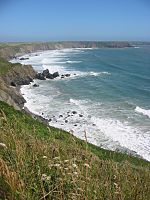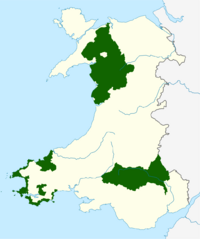National parks of Wales facts for kids
- Snowdonia (Eryri)
- Brecon Beacons (Bannau Brycheiniog)
- Pembrokeshire Coast
The national parks of Wales (Welsh: parciau cenedlaethol Cymru) are special areas in Wales, United Kingdom. These places have amazing natural beauty and are protected. Rules are in place to keep the landscape and environment safe.
Together, these parks cover about 20% of Wales. Over 80,000 people live inside them. Each park has its own team, called a National Park Authority. This team helps manage and protect the park.
Wales currently has three national parks:
- Snowdonia (Eryri), created in 1951.
- Pembrokeshire Coast, created in 1952.
- Brecon Beacons (Bannau Brycheiniog), created in 1957.
There are also five "Areas of Outstanding Natural Beauty" (AONBs) in Wales. These are also protected areas. One AONB, the Clwydian Range and Dee Valley, might become Wales' fourth national park.
The three park authorities work together as 'National Parks Wales' (NPW). They share ideas and help each other protect these special places.
Even though they are called "national parks," most of the land is privately owned. These parks are important because they are considered valuable for everyone in the nation.
The Environment Act of 1995 says that the national parks in Wales have two main goals:
- To protect and improve the natural beauty, wildlife, and history of the parks.
- To help people enjoy and understand the special qualities of the parks.
Contents
Managing the Parks
Since 1997, each national park has been looked after by its own National Park Authority. This is a special type of local government group.
About half of the people on each park authority are chosen by local councils. The other half are chosen by the Senedd (the Welsh Parliament). Some represent local communities, and others represent the whole country. The National Park Authority also decides on building plans within the park.
Around 12 million people visit these national parks each year. Almost three out of four people in Wales visit the parks annually.
The Three Parks
Snowdonia (Eryri)
Snowdonia (Eryri) was formed in 1951. It is the largest national park in Wales. It is home to the highest mountain in Wales, England, and Ireland, which is Snowdon. It also has Wales' largest natural lake.
This area is rich in history and culture. More than half of the people living here speak Welsh. You can find fossil shell pieces on Snowdon's summit that are over 500 million years old! The ancient 'Harlech Dome', which includes Snowdon, was formed even before volcanoes erupted.
About 18,000 years ago, huge glaciers during the Ice Age shaped Snowdonia. They created the U-shaped valleys you see today, like those at Llanberis and Nant Gwynant.
The Eryri National Park Authority manages the park. Its main offices are in Penrhyndeudraeth.
Pembrokeshire Coast
Formed in 1952, this is the only national park mainly known for its coastline. It covers almost all of the Pembrokeshire Coast. It also includes every island offshore, the Daugleddau estuary, and parts of the Preseli Hills and Gwaun Valley.
This park is very important for nature. It has many special habitats and rare animals and plants. There are thirteen Special Areas of Conservation and many other protected nature sites here.
The park also has a lot of human history. This includes the UK's smallest city, St Davids, and old Iron Age forts. There are also sixty important geological sites, from small quarries to long stretches of coastline.
The Pembrokeshire Coast National Park Authority manages the park. They also look after the entire Pembrokeshire Coast Path. This walking path is about 186 miles long and is almost entirely within the park. Over 26,000 people live in the park.
Brecon Beacons (Bannau Brycheiniog)
The Brecon Beacons National Park was formed in 1957. In 2023, it was renamed to its Welsh name, Bannau Brycheiniog. This park connects the countryside of mid-Wales with the industrial areas of South Wales.
It stretches from Llandeilo in the west to Hay-on-Wye in the northeast. It covers about 519 square miles. The park has four main areas: the Black Mountain in the west, Fforest Fawr and the Brecon Beacons in the middle, and the Black Mountains in the east. The highest point here is Waun Fach, which is 811 metres (2,661 feet) high.
The park's mountains are mostly made of a type of rock called Devonian Old Red Sandstone. This rock forms the highest point in South Wales, Pen y Fan, which is 886 metres high. Like other mountain parks, glaciers from the Ice Age helped shape many of its famous landforms.
The western part of the park is also a Fforest Fawr Geopark. This means it's recognized for its amazing geology. It includes a beautiful area known as Waterfall Country. You can also find old tramroads and the Monmouthshire and Brecon Canal here. These were used during the Industrial Revolution and are now great for recreation.
The Bannau Brycheiniog National Park Authority manages the park. They are responsible for protecting the landscape and helping people enjoy it. They also handle planning decisions for the park area.
List of National Parks
| Name | Photo | County/ies | Date formed | Area |
|---|---|---|---|---|
| Snowdonia (Eryri) |  |
Gwynedd, Conwy 52°54′N 3°51′W / 52.900°N 3.850°W |
18 October 1951 | 2,142 square kilometres (827.0 sq mi) |
| Pembrokeshire Coast (Welsh: Arfordir Penfro) |
 |
Pembrokeshire 51°50′N 5°05′W / 51.833°N 5.083°W |
29 February 1952 | 620 square kilometres (239.4 sq mi) |
| Brecon Beacons (Bannau Brycheiniog) |
Blaenau Gwent, Carmarthenshire, Merthyr Tydfil, Powys, Rhondda Cynon Taf, Monmouthshire, Torfaen, Caerphilly 51°53′N 3°26′W / 51.883°N 3.433°W |
17 April 1957 | 1,351 square kilometres (521.6 sq mi) |
Future National Parks
People have suggested two other areas in Wales could become national parks:
- North East Wales National Park: This area, which includes the Clwydian Range and Dee Valley AONB, has been suggested since 2010.
- Cambrian Mountains: People have been trying to get national park status for the Cambrian Mountains since the 1960s. Campaigns for this park in Mid Wales are still ongoing.
How the Parks are Funded
The three National Park Authorities get most of their money from the Welsh Government. About 75% of their national funding comes from the government. The remaining 25% comes from a special local tax called a National Park levy.




